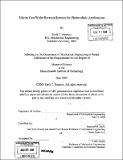| dc.contributor.advisor | Emmanuel M. Sachs. | en_US |
| dc.contributor.author | Hantsoo, Eerik T. (Eerik Torm) | en_US |
| dc.contributor.other | Massachusetts Institute of Technology. Dept. of Mechanical Engineering. | en_US |
| dc.date.accessioned | 2009-06-30T16:48:03Z | |
| dc.date.available | 2009-06-30T16:48:03Z | |
| dc.date.copyright | 2008 | en_US |
| dc.date.issued | 2008 | en_US |
| dc.identifier.uri | http://hdl.handle.net/1721.1/45954 | |
| dc.description | Thesis (S.M.)--Massachusetts Institute of Technology, Dept. of Mechanical Engineering, 2008. | en_US |
| dc.description | Includes bibliographical references. | en_US |
| dc.description.abstract | Current industry-standard methods of manufacturing silicon wafers for photovoltaic (PV) cells define the electrical properties of the wafer in a first step, and then the geometry of the wafer in a subsequent step. The geometry is typically defined by a combination of grinding and abrasive wire sawing. While mature, these processes remain slow and wasteful of raw materials. As the PV industry scales to meet increasing global demand for renewable energy, new processes for creating wafers must be explored. This project sets out to enable high-speed casting of individual wafers, by developing a zone recrystallization process to improve rapid-cast wafers of low electrical quality. In the process, individual wafer geometry is defined in an upstream high-speed casting step with little regard to electrical quality. Subsequently, the electrical properties (through grain structure, dislocation density, and segregation of impurities) are optimized by zone recrystallization. The work outlined in this report documents the development of a custom, high- purity zone recrystallization furnace; an encapsulation mechanism for molten wafers; a mechanical fixturing scheme to preserve the planarity of recrystallized samples; and a release layer to prevent adhesion of the wafer to support structures. Further, the results of experiments investigating temperature profile effects on defect density and grain structure are discussed. Specifically, results demonstrating completely redefined grain structure and improved dislocation density are disclosed. Minority carrier lifetime measurements are also disclosed. Although still preliminary, overall results are promising for the successful refinement of small-grained, rapid-cast wafers into large-grained, high-lifetime wafers suitable for use as high-efficiency PV cells. | en_US |
| dc.description.statementofresponsibility | by Eerik T. Hantsoo. | en_US |
| dc.format.extent | 122 p. | en_US |
| dc.language.iso | eng | en_US |
| dc.publisher | Massachusetts Institute of Technology | en_US |
| dc.rights | M.I.T. theses are protected by
copyright. They may be viewed from this source for any purpose, but
reproduction or distribution in any format is prohibited without written
permission. See provided URL for inquiries about permission. | en_US |
| dc.rights.uri | http://dspace.mit.edu/handle/1721.1/7582 | en_US |
| dc.subject | Mechanical Engineering. | en_US |
| dc.title | Silicon cast wafer recrystallization for photovoltaic applications | en_US |
| dc.type | Thesis | en_US |
| dc.description.degree | S.M. | en_US |
| dc.contributor.department | Massachusetts Institute of Technology. Department of Mechanical Engineering | |
| dc.identifier.oclc | 321072021 | en_US |
